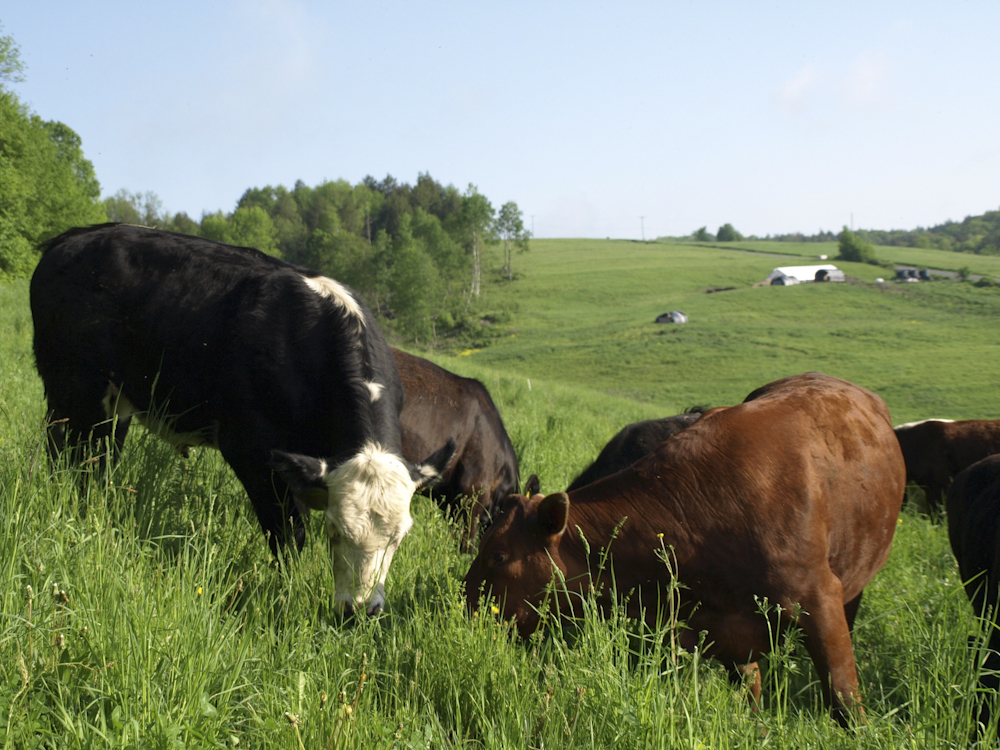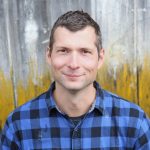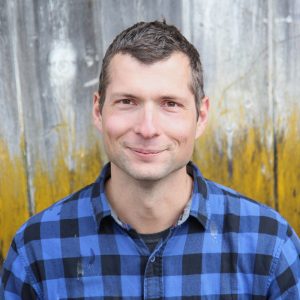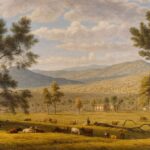Early in my farming career I hit a groundhog hole while driving across a hill. My three-ton tractor lifted, and for a moment the tire on my left became as buoyant as a balloon, ready to float in an arc up over my head. To feel a machine so slow and determinedly grounded be suffused with such uncertainty, to feel it waver in indecision between rumbling on its way and taking a glorious tumble through the clover, shot me through with terror but also with a strange, electric readiness. The hot, dry air was filled with the smell of goldenrod, and the green of the orchardgrass and the hazy sky became near artificial in their clarity, as the landscape fixed in a moment which held and stretched. Then the wheels churned forward another foot and settled, and I white-knuckled the steering wheel back to the barn, grinning the whole way.
The danger of motoring around on steep hills is obvious. But there are plenty of other ways to be maimed or killed on a farm, from felling trees to getting tangled in a PTO to asphyxiating in a grain bin. And there’s the livestock. A human of average size and ability might come out on top in a catch-as-catch-can bout with a sheep, but a full grown sow, with her low center of gravity and inexorable snout, is a bulldozer wearing a lard poncho. Once decided on a course, she moves with a healthy agnosticism towards things like fences, trees, and flimsier outbuildings. The feeble hands of a farmer are nothing to her.
When I was apprenticing on a dairy high in the French alps, making cheese and milking the herd of robust, rust colored cows, I was called upon to assist with a minor medical procedure of the sort that arises on any livestock operation. A yearling heifer, upon being reunited with her mother, had started nursing again. Normally such a regression to infancy isn’t tolerated, but this particular cow had a modern sensibility, or perhaps the heifer was singularly determined. Regardless of the problem’s cause, the solution was nasty and straightforward; her nose had been pierced with a spiky metal ring, so that when she went to suckle it jabbed the downy skin of her mom’s udder. After a few pricks to the undercarriage they’d sorted it out, meaning the cow had kicked the heifer enough times to convince her that the milk bar was closed for good. Now our task was to remove the piercing.
My host Michel was a stocky Savoyard, possessed of a fondness for tight jeans and beer laced with saccharine mint syrup, and he belched as he bellied up to the heifer while tugging from his back pocket a purpose made tool that looked like a pair of pliers reshaped above the pivot point, so instead of pinching they could lock onto the ring to either squeeze it closed or pry it open. He showed me how he wanted her held and then pantomimed flexing to let me know I couldn’t be half-assed about the thing.
She was a fine example of the local cattle, shorter and more athletic than a holstein, with trim, pointed hooves and a wide stance inherited from generations of ancestors that had managed to not fall from any of the area’s numerous cliffs. Bracing my hip against her shoulder I took hold of her horns, each smooth and hot as a mug of diner coffee beneath my palm, and decisively pulled her head towards me. Naturally, she moved it the other way, a contest that established our relative strength and found me lacking.
Her eye met mine, and then with slow deliberation she lifted her hoof and placed it atop my boot.
Michel saw this and said “costaud!”, then threw his hip against the other side of her neck. Her collar was chained to the wall of the barn, and between that and the way we’d pinched her she held still enough for him to bring the tool to bear. As he worked to fit it over the nose ring her eye met mine, and then with slow deliberation she lifted her hoof and placed it atop my boot. At that she stopped struggling, her only movement being a shifting of weight to nail my foot to the concrete floor. While Michel muttered “merde!” and “bon dieu!” she stepped harder, and spikes of pain radiated up my ankle and out the ends of my toes. I was about to yell, let go, start extricating myself by any means, when the ring popped free, and we all sprang away from each other at once.
Here I’ll say a few words about the most obvious purpose of this place where a cow stood on my foot so hard it hurt for a week and where sparse grass grew on slopes with terraced paths worked across them and where a family had for generations turned a perishable summer’s worth of milk into something beautiful and enduring, by which I mean cheese. The stuff they made shared the name Abondance with the region and its cattle, and while I imagine its production was more streamlined in the larger factories and cooperatives, at this particular alpage the recipe consisted of a series of food safety violations arranged in careful sequence. I spent my whole time in France eating cheeses with abandon, focusing particularly on those too raw or too rare to find in America, and this was without qualification the finest of them.
Writing about flavor is almost as fruitless as writing about music. Despite a possible range from the literal (sweet, tart, salty) to the wonderfully abstract (“It is a little, shy wine, like a gazelle”), most descriptions land in the boring middle, with a mix of words like earthy, funky, bracingly acidic, and maybe a food like blood orange or fresh fennel, as if the right combination might convey the actual taste of the dry cured sausage the author has just enjoyed. It cannot. Instead, this mode trades any effort at entertainment for an illusion of accuracy. So all I’ll say is that the Abondance made on this farm lived next door to Comte and Gruyere and that eating it evoked the same feeling of ephemeral wonder as morning fog lifting to reveal a distant range of mountains.
It’s easy to think this sort of glorious, improbable particularity can only be produced by lining up the right factors–start with a historic alpine valley, add some sturdy inhabitants and cows, end up with cheese–but this is looking at the thing the wrong way; it implies a clear start and finish, a linear process with a few contextual components at the beginning and a product at the end. This is a poor way to describe the messy variety of a truly human enterprise.
Who cares how good the cheese is if you never sit around enjoying it?
About every other day some relative or friend would hike up unannounced, and immediately all work would cease. The visitor always brought wine, along with bread or maybe some charcuterie if it was another farmer, and the afternoon would be spent drinking and eating and talking around the wide, rough table, pock-faced from Michel’s habit of embedding his opinel pocket knife in it when he wasn’t shaving off thin slices of saucisson sec. Wood splitting and road repair were neglected for hospitality about a half dozen times before I recognized this as not an inefficiency but the most important reason to go up the mountain at all. Who cares how good the cheese is if you never sit around enjoying it? Then there was the less obvious stuff, like spending time in a place where pet horses could stick their heads through the kitchen window and where the sacred peals of the huge bells the cattle wore rose in the fading gray each morning as they ascended to the barn in procession.
The cheese crafted here came about as a byproduct of a larger whole, the natural dividend of a complete way of life, and this is the foundation of the best farming. Viewing soil as a simple medium atop which inputs are converted to outputs degrades both it and agricultural communities, while treating the land as the foundation necessary for life to flourish in all its idiosyncrasies creates the possibility that it will. Nowhere is this more apparent than when living closely with livestock, which inevitably highlights a couple implicit tenets underlying the spiritual handshake of domestication. There must, of course, be an immediate, tangible benefit to each party, like a reliable source of pasture for cows and a reliable source of burgers for humans. But more importantly, over generational time the species that have yoked themselves to each other as well as their environment must both be deeply enriched by the partnership.
Treating the land as the foundation necessary for life to flourish in all its idiosyncrasies creates the possibility that it will.
On my farm here in central New York, moving the stock to new grass follows a pattern, with the cattle wandering over to stand against yesterday’s temporary fence as I set up today’s. If they think I’m taking too long about it, which they always do, they’ll start mooing their displeasure. When I finish and reel in enough line to make an opening the herd streams through it close enough for me to touch, meaning close enough to touch me. But twenty tons of living flesh, bone, and glistening black hide rumble past, shoulders and heads pushing and jostling in the rush for that first fresh muzzleful, without ever brushing against me. In the moment of release afterwards, as frenetic sound and movement give way to the quiet of tearing grass, and as each cow finds her place, the miracle of so much life at its use is an overwhelming beauty. I’ve been passed by a kinetic torrent that could easily have pulped me into the ground, but the hooves and teeth have instead gone to their work.
I’ve witnessed this slow, strange alchemy reshape the land, as the presence of animals living their lives has transformed thistle and buttercup and shrub to clover and grass. Any system of management will benefit some plants while limiting others, and it’s a perfect rhyme that good grazing creates good pasture. Over the years the interplay of livestock and plants enriches the earth itself so it can in turn grow more cattle, along with bobolinks and voles and red foxes and short eared owls. With this unfolding in front of me it’s easy to think any danger, whether getting shocked by the fence or breaking my leg in a groundhog hole, is of a kind with eating raw cheeses in France: real but not excessive, and more than justified by the variety and pleasure of the experience.
Last May I’d just completed this daily drama when I saw that a straggling cow and her calf were trying to rejoin the others. When I bought the huge angus from a neighbor she’d been rawboned and terrified, so flighty that she’d light off at an ungainly gallop any time I got within fifty yards, but months of living with the other cows, first daily moves across the pasture and then hay feeding through a winter, had settled her. She might still linger at the back of the mob and squeeze through a gate with as much space between me and her as she could manage, but she was more a part of the herd than apart from it. As she calmed she ate, and her thickened shoulders and slicked off coat gave her an air of renewed vitality, an appearance that was confirmed when she stepped over the line of portable fence and dropped a big, bawling calf beneath an ash tree.
But with motherhood came a return of her anxieties. Instead of staying with the herd she began haunting the nearby woods, and from the hilltop she watched as the other cows moved away, one allotment of ground at a time. Within a month the calf had started roaming, as all calves do, with the fretful cow trailing behind and stopping every few paces to low at her incautious offspring. They’d been out to meet the pigs and down by the little pond to browse on cattails, and now their wanderings had finally brought them close to the herd. The calf was running and kicking up its hind legs in anticipation of spending time with cows that weren’t its mom, so I opened up the fence to shoo them in.
I felt myself attuned to the straightforward sign language of my cattle, with a dropped head or hoof pawing the ground telling me to back off. But it was a profound failure of observation and imagination on my part not to realize the strangeness of this particular cow remaining still as I walked closer. I’d stepped within five paces of her when she lurched forward and butted me in the chest, so fast I’d no time to move and so powerful I left the ground. My memory of the next few moments is more impressionistic than linear, the images and sensations of being airborne, my side hitting the ground, rolling away as the dark curve of the cow’s stomach passed over me all bleeding together into urgent action too pressing for fear or thought.
Though I’d been in the middle of the field I found myself standing beside the sturdy perimeter fence, ready to vault it. But the cow had not followed, and I gazed at her without comprehension until she turned to rejoin her calf, who was standing contendly with the rest of the herd. My heart ran itself out in my chest, as dumb, adrenalized anticipation faded into a permeating dullness, a torpor that took hold of my soul. Dew dried from grass stained knees in the rising heat, and the sun had burned off the mist above the swamp on the far side of Highway 51. The hogs at the end of the pasture and the sows and boar up in their hoop all still needed feeding. My house, a thumbprint of white, lay far below in the barnyard. In it my wife drank coffee while my daughter ate her eggs and my son screamed about how he wouldn’t. The whole thing was achingly perfect, and I knew then that I could never deserve it.







4 comments
Mark Manry
I enjoyed this essay and its celebration of the risks inherent to farming life. The hope you expressed in your bio to “balance the demands of an agricultural ecosystem with those of the market” reminded me a line W. Berry expressed in a long poem called “The Farm” (1991) in which he describes a “…vision, seen as on a Sabbath walk: The possibility of human life whose terms are heaven’s and earth’s.” Let it be so.
Garth Brown
Thanks, Mark. Five or six years ago I went to a presentation about soil health and biodiversity by the late Jerry Brunetti up in Little Falls. The next day, as looked across my farm, I had an idea of what it might one day be, with healthy soils, newly planted trees growing on every fence line, woods and pasture blending porously into each other, and ongoing experiments with some perennial plants that are overlooked, despite having real potential for a productive farm, like bamboo and Jerusalem artichokes. It’s an endless process to build anything like that, and there is often a financial disincentive to put resources into such long term projects. This is why I love orchards, vineyards, coppices and hedges. They are work done with a generational dividend in mind.
Garth Brown
Hi Marilyn, thanks for reading. I did use the word bleeding intentionally, though I can see how it might be confusing.
Marilyn Chiaramonte
Garth, another wonderful essay. I enjoy reading the monthly “installments” and this one, being a bit longer, was extremely pleasurable. Just one quick question: plagued as I am by have to check spell check when it tries to change that which I want to say into that which it wants to correct, I’m wondering if it did the same in the last sentence of the penultimate paragraph, changing blending into bleeding; or was bleeding your intended description?
Comments are closed.